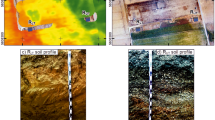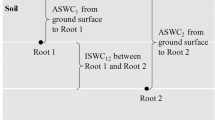Abstract
Mycorrhizal symbiotic plants, soil suitability, temperature, and humidity are, by general consensus, considered decisive factors in truffle production. However, experimental approaches to define the environmental conditions that stimulate formation of truffle primordia and promote their growth to maturity have been lacking. By analysis of data of many atmospheric and soil parameters collected since 2009 within a Tuber melanosporum orchard, the trends of metabolic activity, detected as CO2 production in the soil, have been identified as the most reliable parameter to indicate the ‘birth’ of the truffle primordia. They seem to be produced when mycelial activity is intense and undergoes water stress, after which it resumes. About 6–18 days after recovery of metabolic activity, we could collect primordia of T. melanosporum. Many die or develop too early and consequently rot or are eaten by insect larvae. These events occur several times during summer and autumn, those that ‘sprout’ in late summer or later grow steadily and reach maturity. Using a particular ground-penetrating radar (GPR) setup to discriminate truffles, we could identify individual truffles in the soil after they have enlarged to at least 6 mm in diameter and follow their growth in volume and diameter over time. These two instrumental methods (CO2 sensor and GPR), although yet to be improved, open new important perspectives to better understand truffle biology and manage truffle orchards to support the newly acquired demonstration of the fundamental role of host plants for the nutrient transfer to the ectomycorrhiza-mycelium-fruiting body complex of T. melanosporum.



Similar content being viewed by others
References
Allen RG, Pereira LS, Raes D, Smith M (1998) Crop evapotranspiration—guidelines for computing crop water requirements—FAO Irrigation and drainage paper 56, Rome. http://www.engr.scu.edu/~emaurer/classes/ceng140_watres/handouts/FAO_56_Evapotranspiration.pdf
Arneth A, Kelliher FM, Gower ST, Scott NA, Byers JN, McSeveny TM (1998) Environmental variables regulating soil carbon dioxide efflux following clear-cutting of a Pinus radiata D. Don plantation. Geophys Res 103:5695–5705. doi:10.1029/97JD03464
Bardet M-C, Fresquet C (1995) Influence de la pluviométrie et de la température du sol. Infos-CTIFL 110:38–41
Cantarelli A, Cantarelli P, Di Natale M, Pacioni ML, Pacioni S (2013) Planned and synchronized production of the mushroom Pleurotus eryngii by physicochemical and mechanical traumas. Italian Patent 0001398127
Coquelin A, Torre F, Del-Négro R (2007) Modélisation de la formation de l’ascocarpe de la truffe noire Tuber melanosporum en fonction du couple humidité-température du sol. Ecologia Mediterranea 33:15–28
Davidson E, Belk E, Boone RD (1998) Soil water content and temperature as independent or confounded factors controlling soil respiration in a temperate mixed hardwood forest. Glob Chang Biol 4:217–227. doi:10.1046/j.1365-2486.1998.00128.x
Delire C, Foley JA (1999) Evaluating the performance of a land surface/ecosystem model with biophysical measurements from contrasting environments. J Geophys Res 104:16895–16909. doi:10.1029/1999JD900212
Goodman D, Nishimura Y, Rogers JD (1995) GPR time slices in archaeological prospection. Archaeol Prospect 2:85–89. doi:10.1002/1099-0763(199506)2:2<85::AID-ARP6140020204>3.0.CO;2-#
Grünzweig JM, Hemming D, Maseyk K, Lin T, Rotenberg E, Raz-Yaseef N, Falloon PD, Yakir D (2009) Water limitation to soil CO2 efflux in a pine forest at the semiarid “timberline”. J Geophys Res 114, G03008. doi:10.1029/2008JG000874
Hall I, Brown G, Zambonelli A (2007) Taming the truffle. The history, lore, and science of the ultimate mushroom. Timber Press, Portland
Hirano T, Kim H, Tanaka Y (2003) Long-term half-hourly measurement of soil CO2 concentration and soil respiration in a temperate deciduous forest. J Geophys Res 108:4631. doi:10.1029/2003JD003766
Hruska J, Cermak J, Sustek S (1999) Mapping tree root systems with ground penetrating radar. Tree Physiol 19:125–130. doi:10.1093/treephys/19.2.125
Jol HM (2009) Ground penetrating radar: theory and applications. Elsevier Science, Amsterdam
Kitajima K, Anderson KE, Allen MF (2010) Effect of soil temperature and soil water content on fine root turnover rate in a California mixed-conifer ecosystem. J Geophys Res Biogeosci 115:G04032. http://anderson.drupalgardens.com/sites/anderson.drupalgardens.com/files/2009JG001210-pip.pdf
Kües U, Liu Y (2000) Fruiting body production in Basidiomycetes. Appl Microbiol Biotechnol 54:141–152. doi:10.1007/s002530000396
Kües U, Martin F (2011) On the road to understanding truffles in the underground. Fungal Genet Biol 48:555–560. doi:10.1016/j.fgb.2011.02.002
Lacourt I, Duplessis S, Abbà S, Bonfante P, Martin F (2002) Isolation and characterization of differentially expressed genes in the mycelium and fruit body of Tuber borchii. Appl Environ Microbiol 68:4574–4582. doi:10.1128/AEM.68.9.4574-4582.2002
Le Tacon F, Zeller B, Plain C, Hossann C, Bréchet C, Robin C (2013) Carbon transfer from the host to Tuber melanosporum mycorrhizas and ascocarps followed using a 13C Pulse-Labeling Technique. PLoS ONE 8:e64626. doi:10.1371/journal.pone.0064626
Oei P (2003) Mushroom cultivation, appropriate technology for mushroom growers. Backhugs Publishers, Leiden
Olivier J-M, Savignac J-C, Sourzat P (2012) Truffe et trufficulture. Fanlac editor, Périgueux, France
Ow LF, Sim EK (2012) Detection of urban tree roots with the ground penetrating radar. Plant Biosyst 146(suppl):288–297. doi:10.1080/11263504.2012.731018
Pacioni G (1986) The sporulation of V.A.M. fungi stimulated by water stress in natural conditions. In: Pearson-Gianinazzi V, Gianinazzi S (eds) Physiological and genetic aspects of mycorrhizae. INRA Press, Paris, pp 713–716
Pacioni G (1991) Wet-sieving and decanting technique for spores extraction. In: Varma AK, Trappe JM, Fortin JA, Norris JR (eds) Methods in microbiology, vol 23, Experiments with mycorrhizae. Academic Press, London, pp 317–322
Pacioni G, Rosa S (1986) An improved filtering apparatus for the “wet-sieving and decanting” technique for extraction of Endogonaceous spores. Bull Br Mycol Soc 19:66–68. doi:10.1016/S0007-1528(85)80064-X
Pacioni G, Ragnelli AM, Miranda M (1995) Truffles development and interactions with the biotic environment: molecular aspects. In: Stocchi V, Bonfante P, Nuti M (eds) Biotechnology of ectomycorrhizae. Plenum Press, New York, pp 213–227
Pagnol J (1983) La Truffe. Ed. Aubonel, France
Parladé J, De la Varga H, De Miguel AM, Sáez R, Pera J (2013) Quantification of extraradical mycelium of Tuber melanosporum in soils from truffle orchards in northern Spain. Mycorrhiza 23:99–106. doi:10.1007/s00572-012-0454-y
Rizzo MD, Gross R (2000) Distribution of Armillaria on pear root systems and a comparison of root excavation techniques. In: Stokes A (ed) The supporting roots of trees and woody plants: form, function and physiology—developments in plant and soil sciences. Kluwer Academic Publishers, Dordrecht, pp 305–311
Rubini A, Paolocci F, Granetti B, Arcioni S (1998) Single step molecular characterization of morphologically similar black truffle species. FEMS Microbiol Lett 164:7–12. doi:10.1111/j.1574-6968.1998.tb13060.x
Suz LM, Martin MP, Oliach D, Fischer CR, Colinas C (2008) Mycelial abundance and other factors related to truffle productivity in Tuber melanosporum-Quercus ilex orchards. FEMS Microbiol Lett 285:72–78. doi:10.1111/j.1574-6968.2008.01213.x
Yelf RJ (2007) Application of ground penetrating radar to civil and geotechnical engineering. Electromagnetic Phenomena 7:103–117
Zarivi O, Bonfigli A, Colafarina S, Aimola P, Ragnelli AM, Miranda M, Pacioni G (2013) Transcriptional, biochemical and histochemical investigation on laccase expression during Tuber melanosporum Vittad. development. Phytochemistry 87:23–29. doi:10.1016/j.phytochem.2012.11.019
Zhou T, Shi P, Hui D, Luo Y (2009) Global pattern of temperature sensitivity of soil heterotrophic respiration (Q10) and its implications for carbon-climate feedback. J Geophys Res 114, G02016. doi:10.1029/2008JG000850
Acknowledgments
We express our thanks to Mr. Giangiordano Roberto, the owner of the truffle orchard for his collaboration, Dr. Fernando Antenucci, CAR of Scerni (Chieti, Italy), for the management of data logger, and Dr. Manuela Rastelli for kindly reviewing the English of the manuscript. We thank the associated editor and the two anonymous reviewers for their constructive comments, which helped us to improve the manuscript.
Author information
Authors and Affiliations
Corresponding author
Electronic supplementary material
Below is the link to the electronic supplementary material.
ESM 1
(DOC 6486 kb)
Rights and permissions
About this article
Cite this article
Pacioni, G., Leonardi, M., Di Carlo, P. et al. Instrumental monitoring of the birth and development of truffles in a Tuber melanosporum orchard. Mycorrhiza 24 (Suppl 1), 65–72 (2014). https://doi.org/10.1007/s00572-014-0561-z
Received:
Accepted:
Published:
Issue Date:
DOI: https://doi.org/10.1007/s00572-014-0561-z




